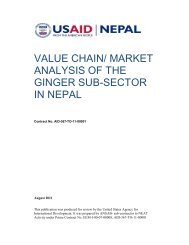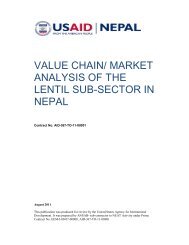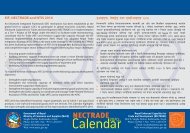value chain/ market analysis of the orthodox tea sub ... - Nepal Trade
value chain/ market analysis of the orthodox tea sub ... - Nepal Trade
value chain/ market analysis of the orthodox tea sub ... - Nepal Trade
Create successful ePaper yourself
Turn your PDF publications into a flip-book with our unique Google optimized e-Paper software.
Table 1 Impact <strong>of</strong> organic transitionOrganic conversionEstimated Calculation1st year2ndyear3rd yearCertifiedDecline in Productivity High Medium Medium MediumIncrease in Price/kg received Medium Medium Medium HighIncreased in COP/kg High High High HighNote: High- 40% to 60%; Medium- 20% to 40%; Low- 0% to 20%(Certification is assumed to be received within 3 years).The above table shows that <strong>the</strong>re will be a high decline in productivity in <strong>the</strong> initial years <strong>of</strong>conversion to organic and hence <strong>the</strong> estimated cost <strong>of</strong> production is high. The cost <strong>of</strong>production is also increased due to high labor requirements, additional costs <strong>of</strong> achievingcertification, and more organic input requirements. The estimated cost <strong>of</strong> certification per <strong>the</strong>factory managers interviewed comes to around 3,000 to 5,000 NPR per year depending on <strong>the</strong>site, area, and type <strong>of</strong> certification as well as <strong>the</strong> inspectors charges. Four to seven extraworkers are required to manage <strong>the</strong> field activities and paper work which is estimated toplace an extra cost <strong>of</strong> 4,000 to 6,000 NPR per year. However, <strong>the</strong> price <strong>of</strong>fered for organic inconversion is more than <strong>the</strong> conventional ones. After achieving organic certification, <strong>the</strong> fullorganic product can receive even higher prices. Similarly, <strong>the</strong> cost <strong>of</strong> certification alsodecreases and <strong>the</strong> productivity increases compared to <strong>the</strong> initial years <strong>of</strong> conversion. Inconclusion, it can be said that though <strong>the</strong> conversion to organic in initial years is notpr<strong>of</strong>itable, and even might have to bear loss, gradually <strong>the</strong> losses are recovered and <strong>the</strong>business will become pr<strong>of</strong>itable in <strong>the</strong> long run.The increased cost in organic cropping can only be <strong>of</strong>fset by ensuring increases inproductivity by <strong>the</strong> use <strong>of</strong> better organic manure and also ensuring premium price for greenleaves.Currently, a good quality <strong>Nepal</strong>i organic <strong>tea</strong> receives an average price <strong>of</strong> 6 to 10 USD per kgin international <strong>market</strong>s whereas <strong>the</strong> conventional <strong>tea</strong> receives only 3 to 4 USD per kg and ismostly sold in Indian <strong>market</strong>s. For <strong>the</strong> organic specialty <strong>tea</strong>s like white <strong>tea</strong>s, silver tips, andgreen <strong>tea</strong>s, <strong>the</strong> price received is 4 to 5 times higher than <strong>the</strong> normal grade <strong>tea</strong>. Therefore,organic <strong>tea</strong> production can provide two to three times increase in export <strong>value</strong> and thus canhave a positive impact throughout <strong>the</strong> whole <strong>value</strong> <strong>chain</strong>.2.2 World Market2.2.1 World Export <strong>of</strong> TeaWith an increased global consumption <strong>of</strong> <strong>tea</strong>, <strong>the</strong> world export <strong>of</strong> <strong>tea</strong> has also increased.Figure 7 presents <strong>the</strong> trend <strong>of</strong> world export <strong>of</strong> <strong>tea</strong> from 2001 to 2010 both in terms <strong>of</strong> <strong>value</strong>(USD in thousands) and quantity (tons).Value Chain/Market Analysis-Orthodox Tea 12






